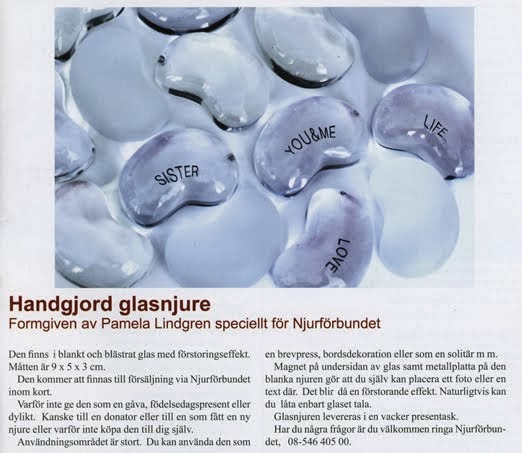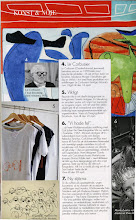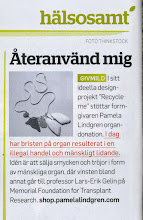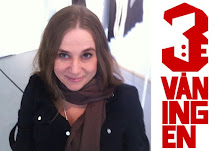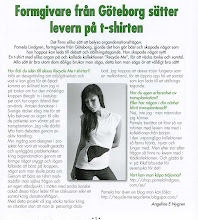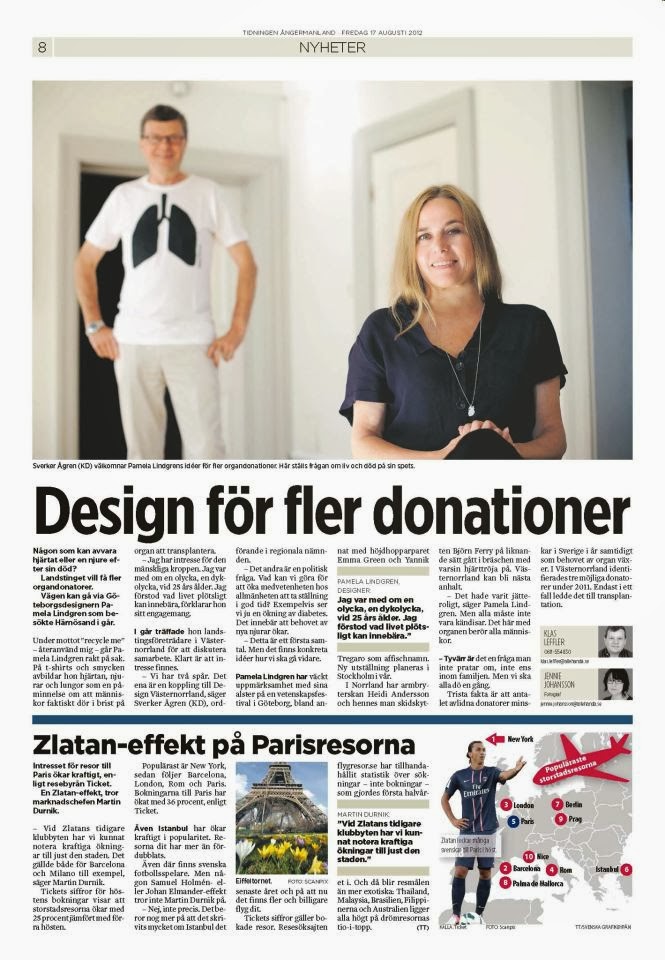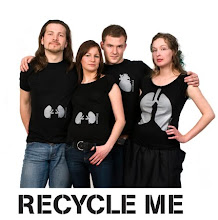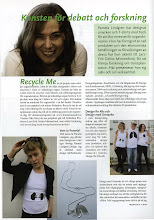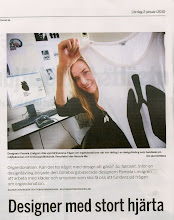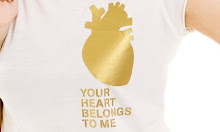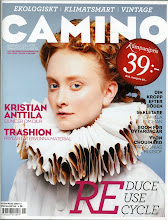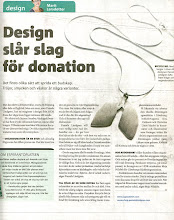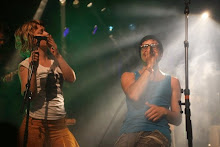Photo and design Pamela Lindgren 2014 ©
Lise-Lotte´s story
Experienced by Lise-Lotte Johansson.
Interviewed,
written and edited by Recycle Me
Translated by Margaret Mayers for Recycle Me.
When I was in Middle School, at a routine
medical check-up, one of our school nurses told me that I had a heart murmur.
She told me that I should get it looked at. I didn’t think much about it at the
time but just let it go. There was such a lot of other stuff to think about for
a young person in the sixties.
Time passed and I got married and had two
daughters. It was not until we were on a family skiing holiday that I felt that
something was wrong. I had headaches and a temperature and visited a doctor who
told me I had pneumonia. Apart from the pneumonia, the doctor thought that my
heart was not sounding good, and she wanted me to get it examined properly. At
that point I remembered the school nurse’s words about a heart murmur.
I underwent an investigation with a lot of
screening, and it turned out that I had hypertrophic cardiomyopathy. This means
that my heart was getting more and more enlarged, not at all a good thing. The main symptom was tiredness, which I’d
always suffered from but never connected to my heart. I was young, only 25
years old, and I had two small children. At that time I was a smoker, and therefore I
had thought that tiredness was a natural aspect of daily life. I remember
however that there were times when the kids rushed off eagerly somewhere, and I
had difficulty in catching them up. I thought that they’d better slow down
because otherwise I’d never catch up with them, I was so tired.
About four years after the diagnosis of my
heart’s continuous enlargement, my doctor suggested an operation to make cuts
in the walls of the heart to make it more elastic with the aid of the scar
tissue that the cuts would create. My husband and I knew our doctor privately and
we were invited to his home to discuss the operation. He asked how I would
prefer them to open my thorax, with a ”snob incision” as he called it, made
horizontally under the breasts, or with a vertical incision between both
breasts.
It made no difference to me but my husband
thought that I should have the incision that was least painful. The doctors
suggested the ”snob incision” since I was so young. Said and done. They opened
my chest with an incision under my breasts and then sawed through the thorax to
get to my heart. The operation went well
and I was able to go home soon after it, but my tiredness was the same as
before the operation.
I was troubled by pains in my chest that I
thought were caused by the wire staples used to join my thorax together again
after they had sawn through it. It is common to use wire for putting the thorax
together again after heart operations, but in my case the wire staples had been
put in with the joins facing outwards, and it was those I could feel through
the skin on my chest, causing pain. Two years later they finally decided to
open me up again and twist the joins of the wire staples inwards behind the
thorax bones instead of in front of them, thus reducing the pain.
This time they used a vertical incision.
The pain diminished slightly. They established that the operation involving
slits in my heart walls had not produced any result. I was given a lot of
diuretic medicines. Later they established that I was suffering from
arrhythmia, uneven heart rhythm. They performed an ablation, which means
burning away a nerve sending the wrong impulses to the heart. It didn’t help. I was getting worse and worse
as the years passed, with atrial fibrillation and atrial flutter which make the
heart beat faster.
During this period of about ten years, I
was working part-time with children at a preschool. My tiredness got worse and
I was having difficulty in coping with the work and its heavy lifts and fast
pace. I changed jobs, starting work as a personal assistent to a disabled
child, but even that was difficult to manage on account of my tiredness. My
heart was unable to oxygenate my body sufficiently, and my tiredness increased.
I underwent cardioversion, which means receiving electric shocks in one’s heart
to make it beat normally.
Shortly after the cardioversion I suffered
a mild stroke and was given anticoagulant medicine to prevent further strokes.
My heart was still causing me trouble and several investigations and methods
were tried but nothing helped. My heart
just got worse and worse. I had to stop taking anticoagulants in connection
with an examination involving the introduction of a tube through my throat, and
two days after that I suffered a further stroke. This time it was much severer
and left me paralysed on one side of my body. It resulted at the same time in
hemispatial neglect which meant that I had a lack of awareness and feeling on
the side of my body that was paralysed. I was in intensive care for several
weeks and after that I was sent Högsbo Hospital for rehabilitation. I made a firm
decision to get well enough to be considered for a heart transplant, but that
was very tough because I was so weak.
My obstinacy was to my advantage. I
recovered slowly and my paralysis left me. I was discharged in December, and in
March the year after I was put on the waiting list for a heart transplant. This
was the year 2006. Three weeks on into March, the phone rang and it was to say
there was a heart for me. My husband, daughters and I drove to the hospital an
hour or so after, and preparations were started the same day as the phone call.
My elder daughter helped me to shower and get washed in three stages from top
to toe with bacteriocidal soap.
I was told not to be too disappointed if it
happened that the heart waiting for me turned out to be unsuitable for
transplantation into me. The size of the new heart was decisive. If it were too
big or too small for my body the transplantation would not take place. I was
given a sedative and after that I can’t remember much more but my family has
told me about it. My family stayed with me the whole time before the operation
and they pushed my bed down to the surgical department with me lying in it.
They describe it as being like a scene out of science fiction when they were
met by steel-surfaced swing doors and green-clad doctors and nurses. They were
told to wait, and it drew out into an eleven-hour wait in uncertainty for them.
During those hours I was on the operating table. The heart was suitable for me!
My first memory when I woke up after the operation
was that I could feel that my feet and hands were warm! I had foot and hand
sweat for the first time in my life. Before I had always felt cold because of
the deficient oxygenation in my body. Now however I had been given a new,
healthy heart that was able to oxygenate me and everything was fine! My kidneys
gave me a bit of trouble after the operation but that got better after a while.
I could start my life!
One drawback of the severe stroke, the
heart operations and the heart transplant is that I now have episodes of
depression and anxiety. I am incredibly thankful for my new heart and life.
That a person whom I did not know actively decided to become a donor is
something that I am also enormously grateful for. I am feeling physically fine
now, but I am suffering from post-traumatic stress. There are times when it’s
hard for me to cope with daily life. My family provides me with huge support.
Without them, I would never have coped.





